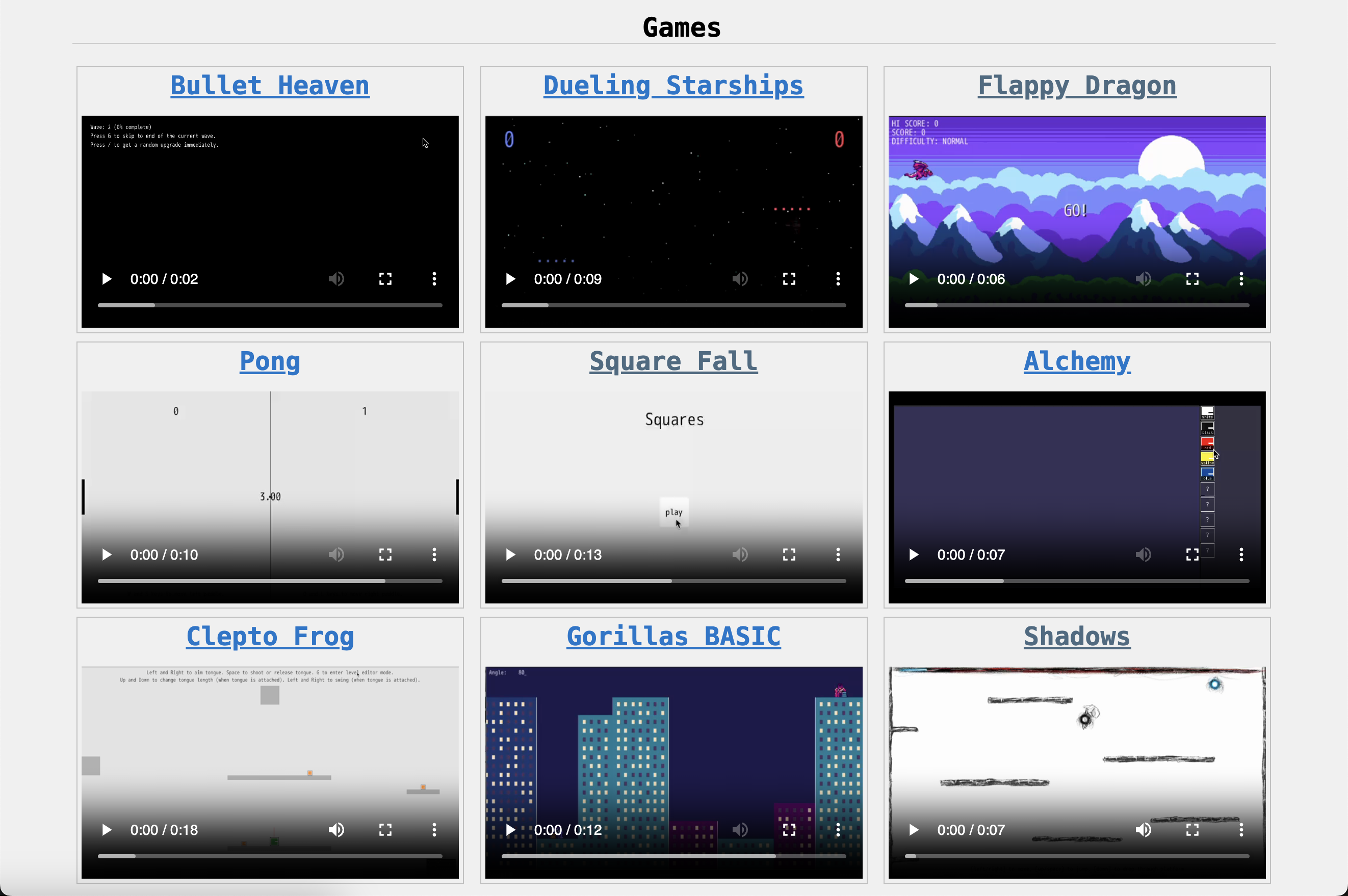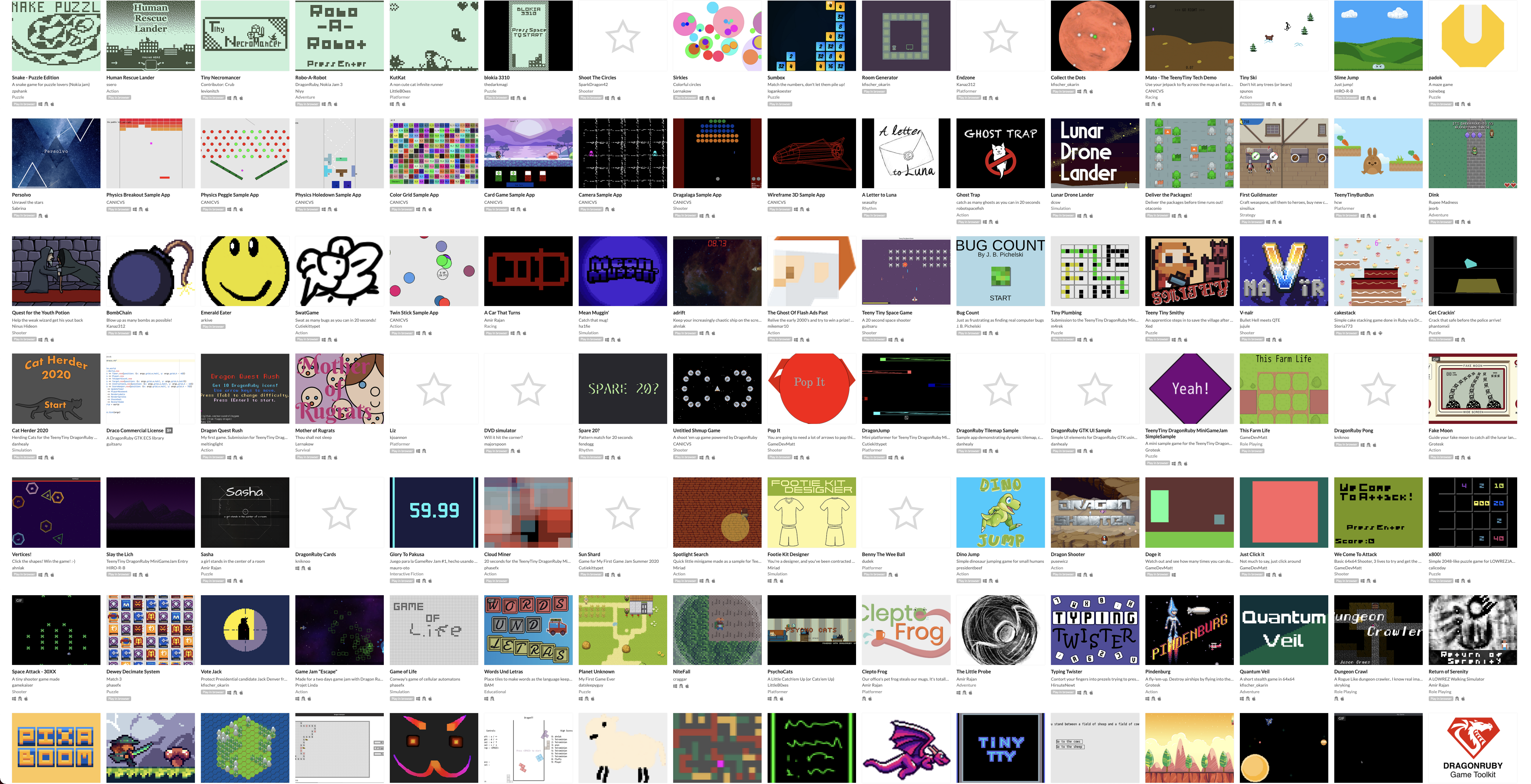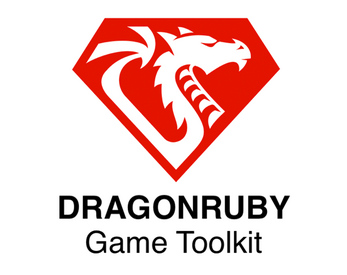DragonRuby Game Toolkit
A downloadable Game Engine for Windows, macOS, and Linux
A cross-platform game engine that's indie-focused, productive, and a joy to use.
Made for Indie Game Devs who want to release cross-platform commercial games. It's royalty-free, fast as hell, and targets everything (all desktop OS'es, Raspberry Pi, Steam Deck, mobile, web, and console).
The people who build DragonRuby use it to build their own games. We eat our own dog food. We're in the trenches with you.
| Updated | Oct 9, 2025, Total releases (so far): 231 |
| Inception | Apr 19, 2019 |
| Category | Game engine |
| Platforms | Windows, macOS, Linux, Raspberry Pi |
| Rating | ★★★★★ (330) |
Free Standard License
You are eligible for a free license if any of the following items pertain to you:
- Your income is below $2000 (USD) per month.
- You are under 18 years of age.
- You are a student of any type: traditional public school, home schooling, college, bootcamp, or online.
- You are a teacher, mentor, or parent who wants to teach a kid how to code.
- You work/worked in public service or at a charitable organization: for example public office, army, or any 501(c)(3) organization.
- Just contact Amir at ar@amirrajan.net or via the DragonRuby Discord Server with a short explanation of your current situation and he'll set you up. No questions asked.
Showcase
5 Min IntroRyan C. Gordon (Icculus) gives a quick 5 minute tour. |
Tech DemoA tech demo showing what DragonRuby is capable of. |
Code + Live DemosDragonRuby ships with 150+ samples (browse the GitHub Repo, skim the Documentation, and check out the Free Book). 
Live Demos
|
In ActionGame Engineering Podcast highlight (link to full interview). |
Conference CoverageDetailed technical overview of DragonRuby. |
Made With DragonRuby400+ games and counting. Read about games made with DragonRuby in the media: The New Yorker, The New York Times, Slate Magazine, Kill Screen. 
Browse Games
|
Testimonials
DragonRuby is one of the Top Rated Game Engines on Itch.io.
|
DragonRuby has really brought the joy of game development back for me, and it's fun to just start a project and see how far I can get - for me it's been really productive and helped me build all sorts of things in a way that made sense and mapped really well to my ideas.
|
Amazing game engine that embraces minimalism in a brilliant way. Even with an absolutely minuscule amount of Ruby experience I was able to get going with this within a couple of days because the API is super friendly to both beginner developers and those who are more experienced.
|
|
DragonRuby is easy to pick up, a game engine with plenty of sensible defaults, and I found it very natural to dive right into the engine and build something. Much of the complexity afforded by other engines is taken care of for you automatically, letting you focus on what matters most (the game!). The greatest part about the engine, in my opinion, is its vibrant community.
|
A great introduction to "real"coding coming from the modern game engine. Great for quick and fun prototyping. Really just a breath of fresh air compared to other engines.
|
|
DragonRuby has been an absolute joy to work with! As opposed to other game dev toolkits, which make me feel like I'm constantly fighting against them, DR feels like a partner in the creative process. The simple API combined with Ruby's expressiveness is a killer combo.
|
Great well built game engine toolkit and fairly easy to learn. Being able to change your code and have those changes happen in real time while the game is running is an amazingly useful feature.
|
|
I love it's pragmatism and straight-forwardness. The code reloading while devloping and the CLI, very Ruby-esque. And the ton of examples where you could find almost everything you could need to build a game of almost any genre. But what I love the most is the community the creators managed to create and cultivate around the framework
|
This game toolkit lets you use your imagination and have a very open ended approach to writing your games, but at the same time takes care of all the most annoying and deal-breaking nitpicky things. Cross-platform is effortless. Hotloading makes experimentation and honing your game very, very fast! I love it and would recommend it to anyone!!!
|
|
Great documentation, countless examples to work from, a true work of passion. It's also ultra portable in that I was able to fetch the executable from the Steam Deck and it ran just fine without dependencies, and no configurations.
|
This is now my favourite 2D game engine. Created by one of the masterminds behind SDL, it is lightweight, very fast, is packed full of clever features (such as hotloading), has a great API and it allows you to write games in Ruby. The community behind it is great, too. Give this a go as an alternative to LÖVE or Unity.
|
|
Brilliant. Not only is it an easy-to-get-into language, but the Discord support is extremely helpful and inviting no matter how little you know about coding, which is completely opposite to the reception I've gotten from some other language-specific support chats.
|
If you know any sort of programming DragonRuby Game Toolkit is an easy way to start game development. There is no complicated UI to interact with. It is all code with a simple API to get things onto the screen quickly and easily. In a matter of minutes it is possible to get a sprite animated and moving around. Since you are writing just code it is possible to make 2d games as simple or complicated as you like.
|
|
One of the best and probably the easiest game development toolkits I've ever worked with. Super friendly and knowledgeable community that's willing to help anyone out, from the first time coder to the triple-A developer.
|
DragonRuby has one of the friendliest, most helpful communities I've found on the internet, let alone the game engine space. The devs are very available on Discord, and actively interact with users new and old alike to give words of encouragement and advice. DR is unopinionated, and gets out of your way when you're making games, providing an easy to understand abstraction layer over the pertinent parts of SDL, and leaving the rest to you. If you love simple game engines without clunky editors, and an ability to go from 0 to 60 quickly, DR is your choice.
|
|
DragonRuby Game Toolkit is the most productive 2D game engine I've used after trying so many out there. It's simple in a great way. With its ability to target all the platforms you could want, it's a good fit for building games of all types and sizes.
|
Each time I code some DragonRuby, I retrieve the joy of coding in a straightforward, personal and creative way. And the toolkit keeps improving fast and in a meaningful manner.
|
|
My first ever game engine and the community that came with it couldn't have been any more amazing. I never thought I wanted to become a game developer but this is a great jumping off point!
|
Absolutely fantastic. Simple, minimalist, fast, and an absolutely fantastic community that is passionate about helping everyone who wants to make something achieve their goals.
|
DragonRuby Indie and Pro Tiers
| Updated | 7 days ago |
| Status | Released |
| Category | Tool |
| Platforms | Windows, macOS, Linux |
| Rating | Rated 4.9 out of 5 stars (344 total ratings) |
| Author | DragonRuby |
| Tags | 2D, dragonruby, engine, Game engine, Moddable, ruby |
Purchase
In order to download this Game Engine you must purchase it at or above the minimum price of $48 USD. You will get access to the following files:
Development log
- DragonRuby Hits v6.0Oct 04, 2024
- 2023 Year End ReviewDec 25, 2023
- Mid-year Update: Quacks, Steam Distribution, Sound Synthesis, and Pixel ArraysJun 08, 2023
- DragonRuby 2023 RoadmapFeb 11, 2023
- DragonRuby + Steam DeckNov 12, 2022
- 3.0 RTM, Oculus VR, Indie Tier, and Black Friday DiscountsNov 22, 2021
- Oculus Quest and DragonRubyNov 10, 2021
- DragonRuby Game Toolkit 3.0 GM ReleasedOct 24, 2021
